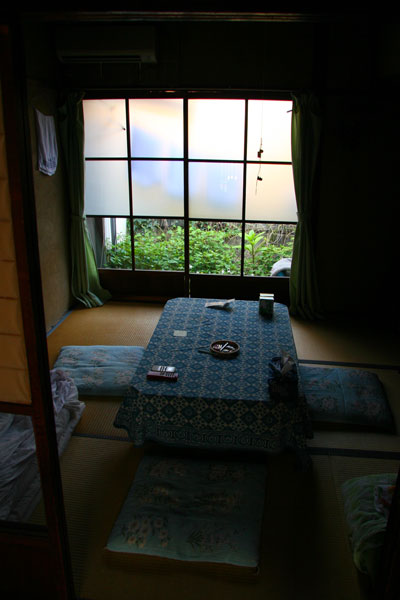
Some travelers can't do without the familiar comfort of four star Western hotels wherever they go, while another type of travelers strive for farmhouse villas in Tuscany or cave dwellings in Cappadocia. If you consider yourself among the latter, then you may well consider renting yourself a traditional Machiya (Japanese Townhouse) when you travel to Kyoto.
What's so special about staying in a Machiya? A Machiya is a prototypical Japanese wooden dwelling typified by a raised Tatami-mat floor suspended in mid-air, with sliding Shoji room-dividers inside, and intricate wooden lattice windows and doors at the exterior. Greatly reduced in number by fire and redevelopment over the past decades, by year 2006 the number of Machiya's remaining within the City of Kyoto had dwindled down to 24000. If you're an adventurous cultural tourist, now is a good time to sample this gradually vanishing traditional way of life.
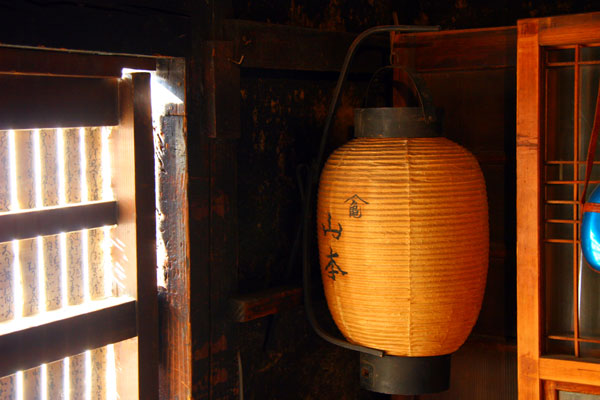 Kyoto Eco-House Machiya
Kyoto Eco-House Machiya is a pilot project run by a grass-root, non-profit group of volunteers to raise awareness for the preservation and revitalization of the city's traditional townhouses. Since July 2000 it's been welcoming artists looking for inspiration and travelers yearning for the most authentic lodging, right at the centre of Kyoto.
It is NOT designed to be a tourist's rental apartment -- instead it's meant to provide an authentic exposure for anyone wishing to experience life in a Machiya as a resident of the old Kyoto. IF YOU'RE A CLEAN FREAK, YOU CAN STOP READING NOW. But for adventurous tourists, there's no better way to live and breathe-in the ancient capital -- authentic Japanese architecture, conveniently located at 5-minute walking distance from a subway and JR train station, and costing less than 5000 yen (CAD$50) per night for two people.
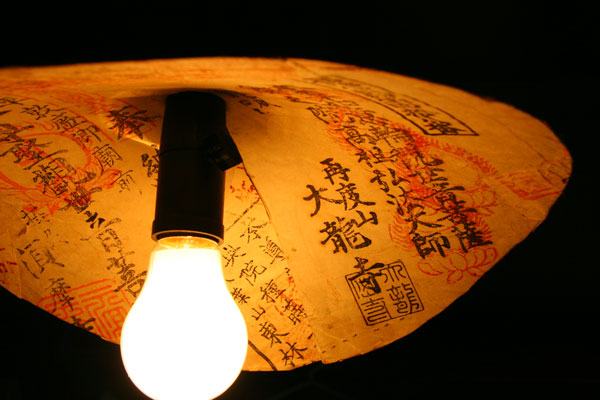
So how does the rental process work? The simplest way is to go to their
official webpage, read their English instructions, then fill in their inquiry/email form. It's a volunteer organization after all, so expect long delays on replies (a few weeks is not unusual, based on my experience). And at its incredibly cheap rental price, also expect it to be fully booked a few months ahead, especially during the summer and Autumn high seasons.
After confirming that our desired dates were available, we then agreed on a time to meet. At our proposed meeting time arrived the friendly Sano-san (so friendly that later he went totally out of the way and drove us 20 minutes to our next sightseeing spot). Upon arrival we were given a tour of the house, instructions on using the facilities (Air-con and Kotatsu!), and an extremely detailed English User's Guide written by a former occupant (see pictures below). We received one set of keys, which we simply dropped off at a certain secret location upon checkout. For the next few days, the Machiya, and thus this incredibly foreign and yet familiar way of life, was entirely our own to explore.
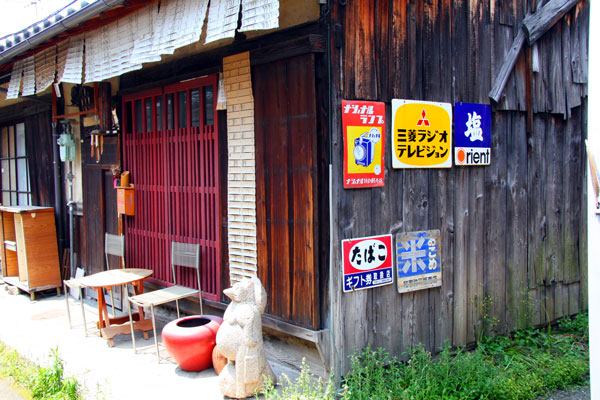 Kyoto Eco-House Machiya
Kyoto Eco-House Machiya from the outside -- a beautifully aged, authentic little Machiya in the classical Kyoto peasantry tradition. The bright signages ("Mitsubishi Radio Television" and "National Lamp"!) brings a certain nostalgic 1950's look to the house, and the stone Tanuki statue at the front dates from the Meiji Era (at least a century old) according to Sano-san. Of course there's also the quintessential feature of all Japanese townhouses -- a wooden Koshi lattice, this one colored in the traditional ocher red. It may look slightly dilapidating, but that's also part of the charm.
Note the bottom edge of the lattice outside is also the base of the Tatami flooring inside. The wooden structure is suspended atop a few independent pieces of foundation stones, with wooden beams placed horizontally on the stones to act as the house's bottom frame. Tatami flooring and room dividers subsequently go on top, and the end result is the typical Machiya structure with a tatami-mat floor suspending in mid air, which is critical for the purpose of improving air-flow and preventing wood decay in Japan's humid summertime.
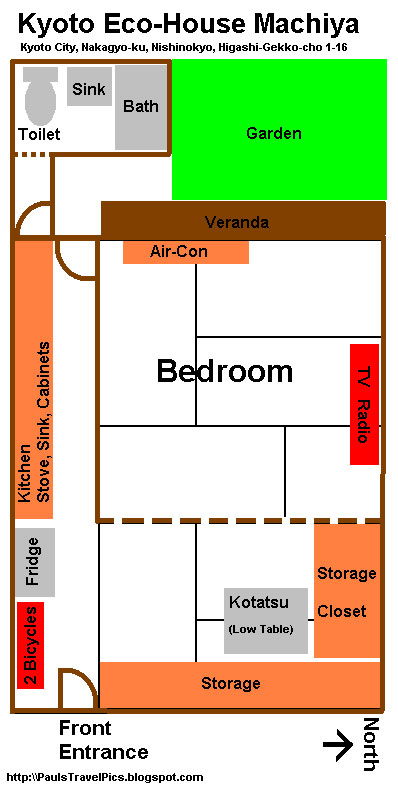
Here's what I remember of the floor plan, for those of you seriously considering renting the Machiya for your vacation. This is what the Japanese call a "2K" (two rooms plus a kitchen) floor plan, with the main room measuring 4.5 Tatami-mats and comfortably sleeping two people. Japanese household necessities are basically all included -- a fully functional kitchen, western-style toilet and bath, air-conditioner, TV and radio, a garden veranda for those starry nights, and a Kotatsu (low table with heater) to huddle on a cold winter morning.
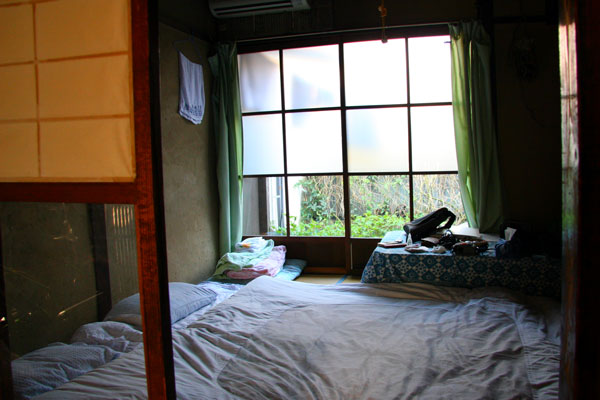
The bedroom is basic but well-equipped with an air-conditioner and a TV, and of course the quintessential Japanese sliding doors opening out to the garden. Pillows, blankets and futon mattresses are all provided, stored away in the storage closet in the daytime. The 4.5 Tatami-mat size is enough to lay out beddings for two people plus some extra space for the low table.
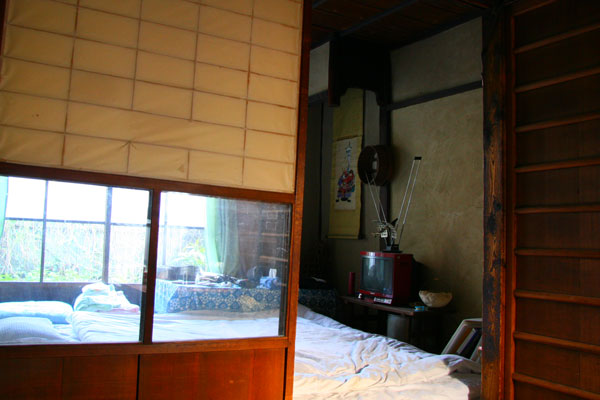
A typical Fusama sliding door separates the bedroom from the front room known as Mise, which in the old days could be used as a store-front. Everything in the room is as authentically Japanese as it gets -- an antenna TV from the 80's, an alcove with a hanging picture, and earthen walls coated with a mud-and-straw plaster mixture.
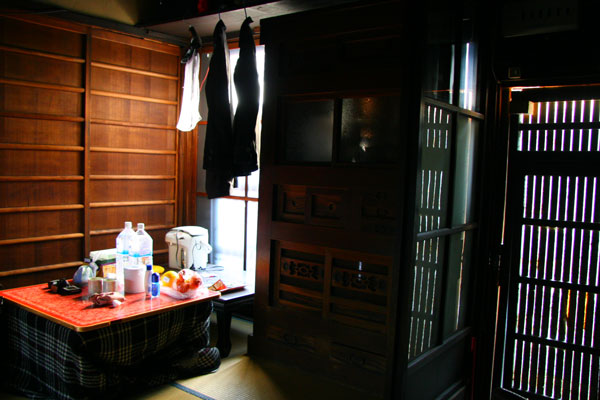
The closets and cabinets of the Mise room provides the Machiya with some much needed storage space. At the bottom left of the picture sits the Kotatsu, a blanket-covered wooden table with a built-in heater, which we didn't use since we stayed during the summer. This is where we always had our home-cooked breakfast before heading out to explore Kyoto.
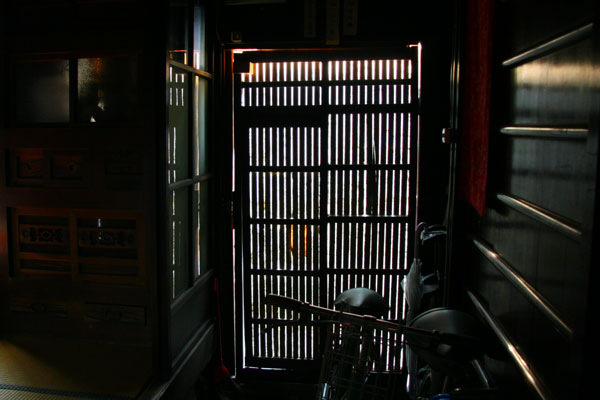
A classic scene in any Japanese townhouse, with the wooden lattice door providing a beautiful balance of light and shadow. Also note a valuable tool for this Machiya's occupants in the foreground -- a couple of old but perfectly working bicycles for exploring the neighborhood and bringing back groceries. Once you learn your way around the block on a bike, you're now fully immersed into the Japanese lifestyle.

A small fridge sits outside the kitchen -- not a full-size family fridge, but perfect for breakfast meats, juices and chilling Sake.
The builder of this house followed a typical Machiya floorplan know as Unagi-no-Nedoko (Eel's Bed), aptly nicknamed for its narrow width and relatively longer depth. In the old days the government collected property taxes based on the frontage of the house, so this type of layout grew in popularity as a simple matter of tax avoidance.
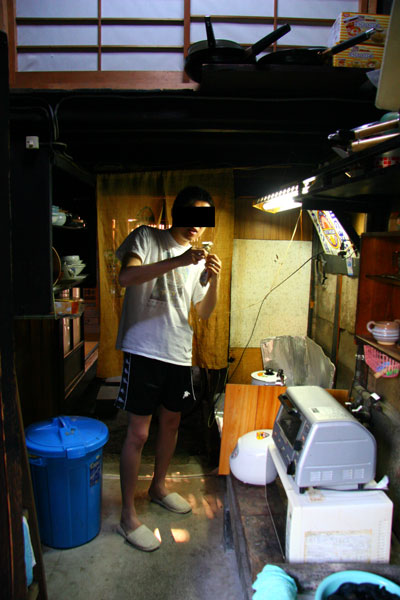
While the entire right side of the house had the Tatami-mat covering a raised floor, the left side contained a narrow strip of unfloored space known as the Doma, stretching from the front entrance space (Genkan) through the kitchen to the garden at the back.
The chaotic little kitchen is said to be over 90 years old. Haphazard-looking and confusing at first glance, we gradually found it surprisingly well-equipped with a gas stove, toaster oven, rice cooker, microwave, and of course pots, pans, kitchen utensils, cleaning supplies, and everything else we needed to cook and serve meals.
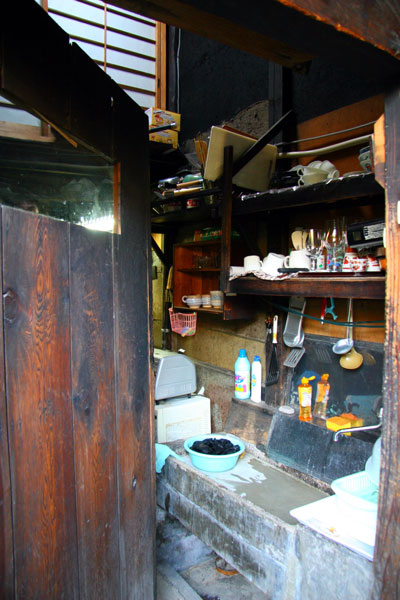
The kitchen sink itself was a rare antique -- a long, slightly slanting stone basin likely built as part of the original house construction. In case you're wondering about the plastic basin, yes this is where we hand-washed our clothes. There are also a couple of coin-laundry places nearby for larger items like the bedding sheets, should you plan for a longer stay.
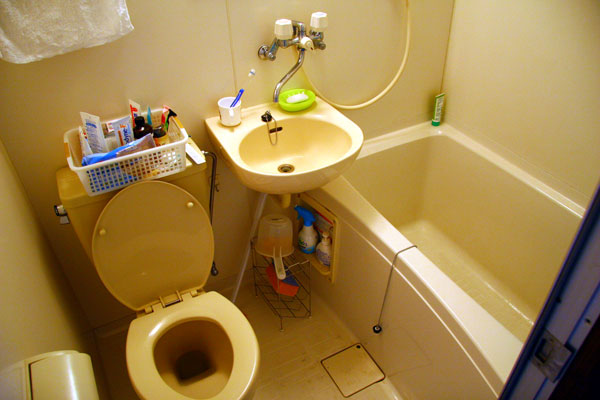
The bathroom is what the Japanese call a "Unit Bath", which is basically a factory-molded module including the bathtub, sink, toilet and even the toilet-paper holder. But the really cool thing is the basket of body lotions, shampoos and toothpastes "donated" by all the previous occupants, which gives this whole project a warm human touch. We didn't add to the collection, but we bought interlocking plastic floormats for the bathroom. The author of the English User's Guide said it very well ... practice some Western pragmatism and throw out the expired items!
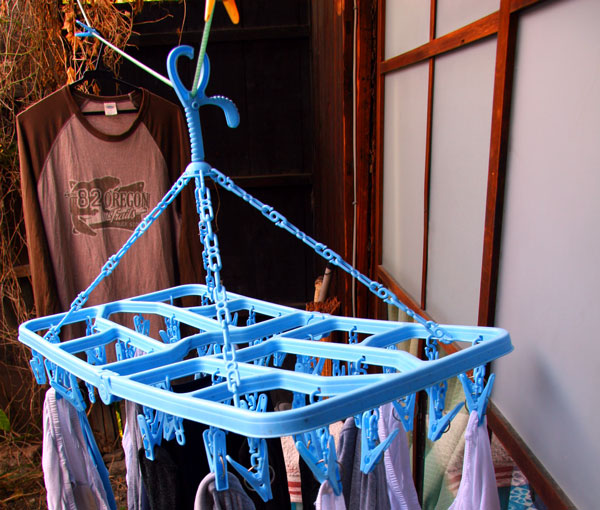
For a few days we had the fortuity to blend in as nameless residents of the ancient capital, hang-drying our clothes in the garden and cooking simple meals in our little kitchen. My only complaint was ... a few nights were way too short for one of life's simple pleasures.
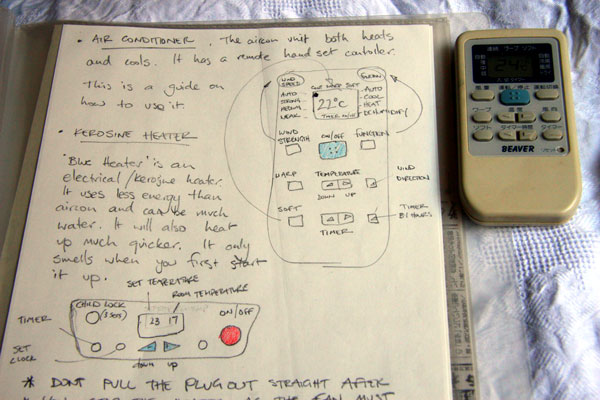
As mentioned, one of the house's former occupants has written an excellent, highly detailed
User's Guide to the Eco-House Machiya in English. Just look at the clarity and depth of the instructions for operating the remote control for the Air-con, and you should have no doubt that any English speaker should get settled in no time.
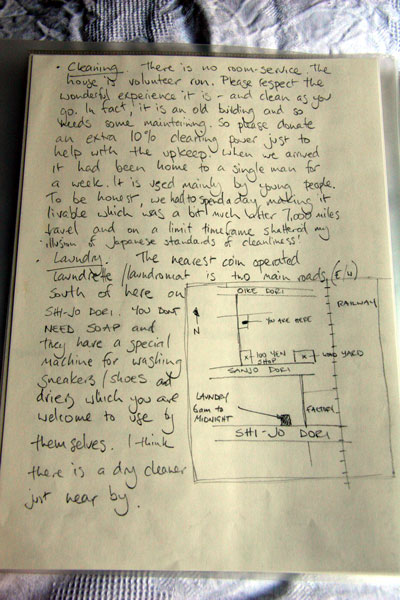
The User's Guide contains instructions for all aspects of making use of the house's equipments, the proper way of setting up Japanese beddings, hand-drawn maps of the neighborhood, where to take out the garbage on which day of the week, and various tips left by different occupants. We did our little part by contributing another local map with the locations of a couple of restaurants and coin-laundry places that we discovered.
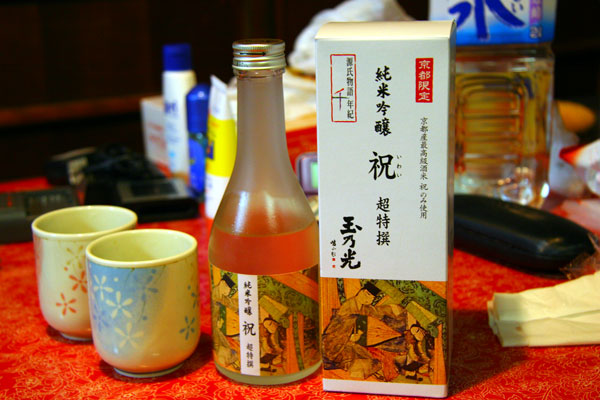
Location-wise this is a really convenient place to settle down and explore Kyoto. A five minute walk to the Northwest brings you to the Nijo Station, a local transportation hub with a JR train station, a subway station, popular City Bus routes such as #206 (to Kyoto Station) and #15 (to Higashiyama), and the Kyoto Bus route #72 (to Saga and Arashiyama). And if you arrive from other parts of Japan (eg.Tokyo) by JR trains, you just pay for your trip to Kyoto and the short trip from Kyoto Station to Nijo Station is free. The same applies in the opposite direction.
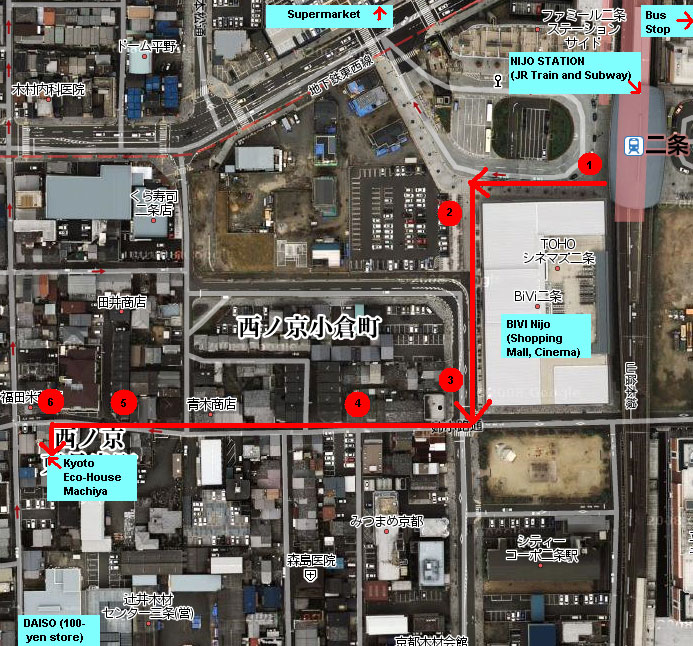
And in terms of living convenience, there's a huge 100-yen store (Daiso) just one minute walking distance to the South, a shopping mall three minutes to the East, and a large supermarket five minutes to the North. For foodies there are a few Izakaya and Sushi-ya, and for the frugal, the MOS Burger and Nakau fastfood outlets are located next to the train station.
If you've
already booked your stay and are wondering how to find the house, just follow the red arrows on the above map, starting from the West Exit of the train station (JR Nijo Station). The numbers inside the
Red Dots correspond to the photos below:
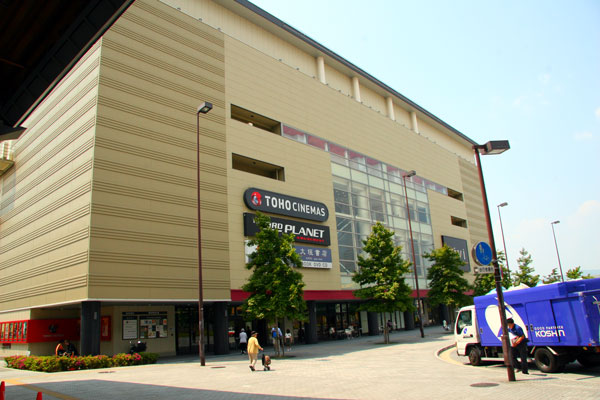
(1) Exit the JR Nijo Station on the West side, and you'll be facing the BIVI shopping centre on your left. Walk towards the far edge of the BIVI (in the direction of the blue truck).
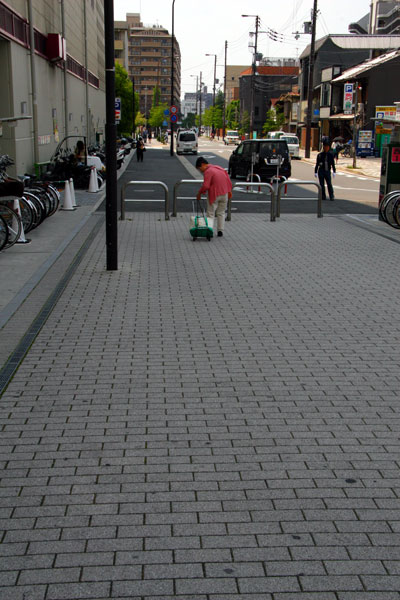
(2) At the end of the BIVI, turn left. You're now heading south, down the West side of BIVI, and you'll be surrounded by parked bikes on the sides.
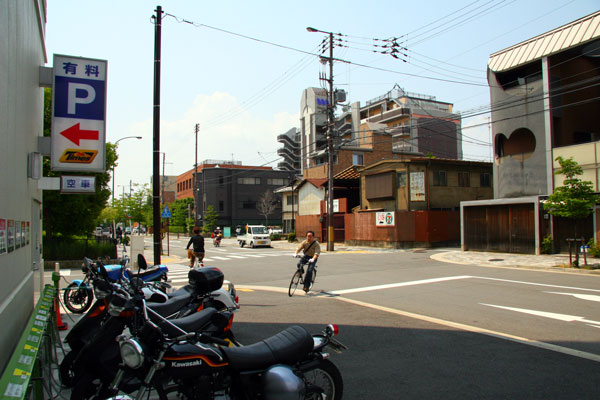
(3) As you reach the end of the building, carefully look for the narrow entrance of the little street on the opposite side of the road. See that 7-Eleven advertisement on the centre-right of the picture? The entrance to the street is just to the right of the advertisement.
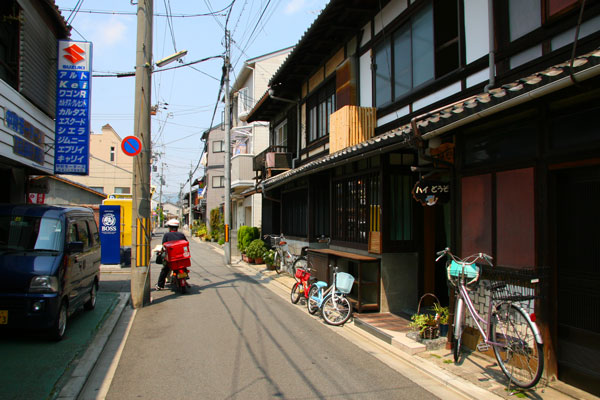
(4) Walk down that little street -- now you're heading west inside a typical residential area, with neighborhood garages and coffee shops along the way.
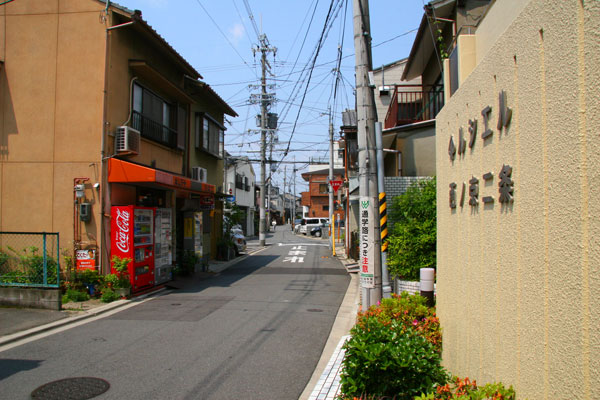
(5) Keep walking for one more minute, and you'll be nearing the end of the block. On your left you'll see a tobacco shop (named Kimuraya) with a couple of vending machines at the front. Just before the tobacco shop you'll see the entrance to a little lane.
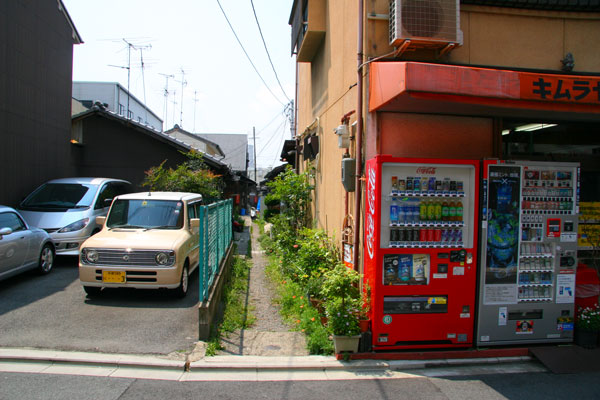
(6) This is what the entrance to the lane looks like, with vending machines on the right side. Don't buy drinks from this vending machine though -- there's a cheaper (100 yen) one just around the street corner to right of this picture. Anyway, now walk down this lane.
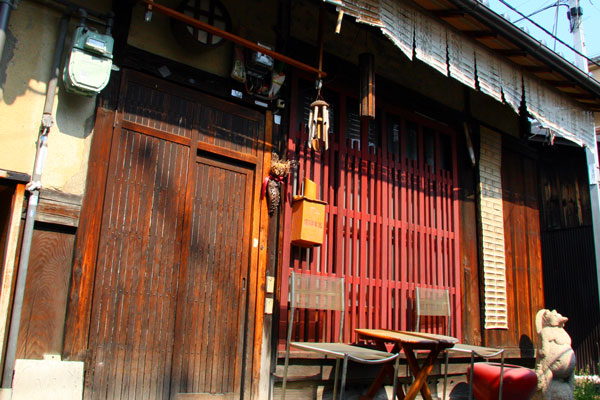
Finally, Kyoto Eco-house Machiya will be on your right, less than 20 steps down the lane. The whole trip from the train station takes less than 5 minutes.
MORE INFO -- FROM THE ANONYMOUS AUTHOR OF THE USER'S GUIDE!
The whole Eco-House experience keeps getting more warm and more human. The anonymous author who hand-wrote the English User's Guide to the Eco-House Machiya has left me a couple of messages, loaded with excellent tips for future visitors. If you're planning to visit, you have to read this ...
Written by the Anonymous Author:
It's a wonderful place and I am so grateful for being able to stay there. I could not have afforded to stay in Kyoto without it being there. It gives one some privacy which is such a relief when traveling and the ability to sink into a local scene escaping foreign voices and attitudes in hostel type accommodation.
I hope those folks that do find there way there honor all that. Your practical directions and clear documentation complete 'the kit' for non-Japanese speakers, otherwise it is pretty impossible to find.
New regulations in Japan mean that new houses have to be so far apart and the streets wide enough for emergency vehicles to get down. My understanding is that the plot the old house is on is just too small to build a new house on.
For folks who have not been there, it is just a gravel lane between other mainly old machiya-type townhouse at present. Perhaps one day the landlord will be able to sell off all the land and it be developed, so do not expect the project to last forever. Its one of those little miracles kept running by goodwill alone.
Although he looks quite hippie, Sano-san, who comes to greet you, is a local priest. The place also gets used for day parties and events. Its tenants are a broad selection from across society and yet they all seem to respect it.
Each time we go back, someone has bought or left something else, fixed this or that, cleaned up here or there and so, somehow, it all keeps working.
Thankfully, there is not much evidence of slackers wrecking the place. Its helps that the Japanese, who are by far the largest proportion of users, are clean and have a social conscience.
If anyone make it to the Eco-house, there is a large "100 Yen shop" on the main street just around the corner that is open until 25:00 hours (no typo there, they must work 25 hour days explaining Japan increased productivity) where you can buy household and kitchen products. Someone needs to replace the slippers we bought a year ago!
One of the other larger machiyas, Paul has pictured, just around from the station has become a very attractive trendy coffeehouse where you can pick up a wifi internet signal. Next door to it, there is a no frills, community-run cafe which giving work to handicapped folk that does simple, hearty but cheap meals.
Food in Kyoto is generally great but I especially recommend the eat-as-much-as-you-like lunchtime buffets at Obanzai, just off Oike-Dori,
http://www.happycow.net/reviews.php?id=83
Better link ... Obanzai is family cooking style.
http://tamakikat.blogspot.com/2008/09/obanzai-restaurant-kyoto.html
|
 Leaf printed linens from Martha Stewart
Leaf printed linens from Martha Stewart

























